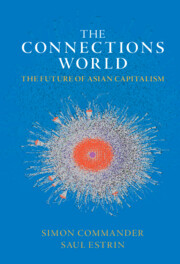Book contents
- The Connections World
- The Connections World
- Copyright page
- Dedication
- Contents
- Figures
- Colour Plates
- Tables
- Acknowledgements
- Abbreviations
- 1 The Strengths and Fallibilities of Asian Capitalism
- 2 To the Foothills of Everest
- 3 The Power of Networks of Connections
- 4 Networks, Connections and Business Organisation
- 5 What Scope for Innovation?
- 6 Employment in the Connections World
- 7 Whither Asia?
- References
- Index
2 - To the Foothills of Everest
Asia’s Resurgence
Published online by Cambridge University Press: 11 October 2022
- The Connections World
- The Connections World
- Copyright page
- Dedication
- Contents
- Figures
- Colour Plates
- Tables
- Acknowledgements
- Abbreviations
- 1 The Strengths and Fallibilities of Asian Capitalism
- 2 To the Foothills of Everest
- 3 The Power of Networks of Connections
- 4 Networks, Connections and Business Organisation
- 5 What Scope for Innovation?
- 6 Employment in the Connections World
- 7 Whither Asia?
- References
- Index
Summary
We provide selective account of how and why the share of Asia in the world economy has more than quadrupled in the past half-century. In 1970, Asia (excluding Japan) accounted for around 9 per cent of the world economy. At the turn of the twenty-first century, this had climbed to 18 per cent and today exceeds 40 per cent. Asian growth has occurred rapidly regardless of political system, institutional arrangements or policy cocktails. We illustrate how far the Asian economies have come and how far they have left to go to attain the living standards of Europe or North America. For example, in India and China income per capita went from just under 5 per cent of the US level each to around 11 per cent and 28 per cent, respectively from 1970 to 2020. The main drivers of growth have been the accumulation of capital and labour along with improvements in the quality of the labour force. We also concentrate on the features that are both a cause and a consequence of the connections world. These include export-led growth, the role of the state, political systems and economic institutions, but also inequality. In so doing, we set the scene for the chapters that follow.
- Type
- Chapter
- Information
- The Connections WorldThe Future of Asian Capitalism, pp. 28 - 65Publisher: Cambridge University PressPrint publication year: 2022



